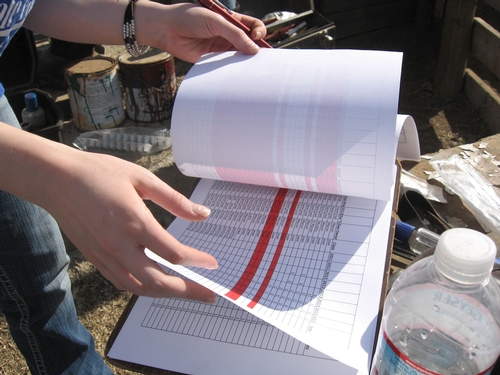
As I continue to think about the question of scale in sustainable farming and ranching, however, I've begun to see the danger in relying on spreadsheets alone. Spreadsheets can tempt us to omit biology from the equation. Let me explain:
There is an upper limit to what an acre of even the most fertile farmland will produce. Based on the yield estimates supplied by Johnny's Seeds, an acre of sweet corn will produce 14,400 ears of corn. Even charging $1/ear, an acre of sweet corn, obviously, won't support a full-time income for the farmer (which is why most local farmers grow more profitable crops). So let's look at a “sexier” (at least according to food writers) crop like kale! An acre of kale will produce 16,275 pounds of harvested product – that's a lot of kale smoothies! My colleague Jim Muck reports that he charges $2 for a half-pound bundle of kale. At that price, an acre field of kale would generate $65,100 in gross revenue – not bad, right?! But wait – aren't there costs associated with growing that acre of kale? Certainly the farmer must put in considerable labor – which has a cost to it. Then there's water, fertilizer, seed, supplies, fuel, marketing costs, storage costs, insurance, land rent (or a mortgage) – that $65,100 in revenue might be offset by as much as $50,000 to 60,000 in direct and overhead costs. In my world, $5,000 to $15,000 isn't enough income to support my family for a year. In other words, the biological limits of my acre of farmland suggest that I need to operate at a larger scale if I want to make a living.
Perhaps livestock operations are different – let's take a look! In our part of the Sierra foothills, an acre of unirrigated rangeland pasture will, on average, grow enough grass to support five mature ewes for one month (these five ewes will need 12 acres of rangeland to get through the whole year). One acre of irrigated pasture will support my five ewes for six months. If I do everything right in caring for my ewes, these five sheep will give birth to 8-10 lambs. If I finish these lambs and sell them as meat at the farmers market, I'll gross $2,400 to $3,000 – all from my acre of land! Just like my friend the vegetable farmer, however, I'll have expenses – things like processing charges, transportation, insurance, land rent, water, veterinary costs, and supplemental feed costs. My net income – which pays my “salary” – is $300-500 from these 8-10 lambs. Once again, biology suggests that I need to operate at a larger scale.
Spreadsheets make it dangerously easy to manipulate these numbers and projections. If I can boost my projected yield of kale by just five percent, it makes my bottom line look much more attractive! Unfortunately, these biological limits don't allow us to fudge our numbers that much. Size, as it turns out, does matter (at least economically).
Don't get me wrong – I'm not advocating for huge monoculture farms. I do think, however, that the romantic notion of micro-farming (less than 2 acres) – the darling of our local food movement – is not the answer, either. If Auburn (for example) needs 25 pounds of kale per person to satisfy local demand for kale, the community would need to grow just over 22 acres of kale. Would 22 1-acre kale farms (none of which would be paying its owner a living wage) be more sustainable, or would it be better to have one or two kale farms that paid the farmer a reasonable annual salary? In other words, do we want a local food system that requires farmers to subsidize their farms with outside income and/or unpaid labor, or do we want a system that is economically viable for consumer and farmer alike? I worry that we may be creating a farming system that requires its farmers to have another source of income (like an off farm job or a retirement fund) in order to keep farming – such a system means we won't likely see young families able to start farms that will be viable over the long term.
I still use spreadsheets in my ongoing attempts to look at the economics of my business, but I've realized that the allure of adjusting the numbers until the farm looks profitable is dangerous (at least for me). My future spreadsheets will begin with the parameters set by the productivity of my land – there is an upper limit to what my soil can produce. My projections must be anchored in reality – and informed by my experience and the experiences of my fellow farmers and ranchers. My spreadsheets must take biology into account!